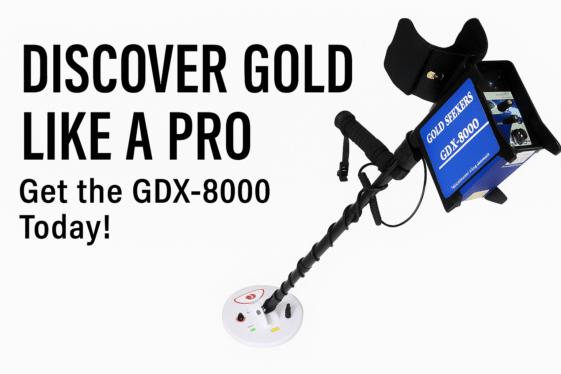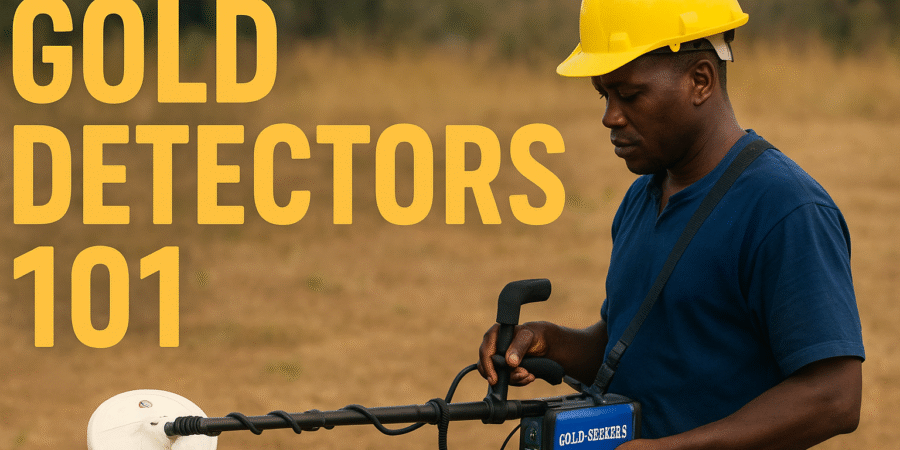If you’ve ever watched videos of people unearthing shiny nuggets from the ground and wondered how they did it, you’re not alone. Gold detectors have opened up a new world of opportunity for treasure hunters, miners, and small-scale gold prospectors across Nigeria and Africa. But before you grab your detector and head for the goldfields, it’s important to understand how these machines actually work.
This guide breaks down the science, types, and techniques in simple language so you can make the most of your gold-hunting journey.
🟡 What Is a Gold Detector?
A gold detector is a specialized type of metal detector designed to locate gold nuggets, dust, and veins hidden beneath the ground. Unlike ordinary metal detectors used for coins or relics, gold detectors are built to sense tiny gold particles buried deep within mineralized soil – a common condition in gold-rich areas like Zamfara, Niger, Kaduna, Kebbi, and Osun States in Nigeria.
Gold detectors work using electromagnetic induction, sending out a magnetic field that interacts with the ground. When the field encounters a metal object like gold, it disrupts the signal, alerting the user with sound or visual cues.
⚙️ The Science Behind Gold Detection
At its core, every gold detector operates on electromagnetic principles. Here’s how it works step-by-step:
- Transmission: The detector’s coil (search head) sends electromagnetic waves into the ground.
- Interaction: When these waves hit a conductive object (like gold), an electric current is induced in it.
- Response: The gold generates its own magnetic field in reaction to the original signal.
- Detection: The detector’s receiver coil senses the new field and translates it into a tone or reading.
The strength and clarity of that signal depend on the size, depth, purity, and shape of the gold, as well as soil mineralization (the natural magnetic properties of the ground).
🔬 Two Main Gold Detection Technologies
Modern detectors use two primary technologies – each with its own advantages depending on where you’re prospecting.
1. VLF (Very Low Frequency) Detectors
VLF detectors transmit continuous low-frequency waves into the soil and analyze the returning signal. They’re ideal for detecting small nuggets at shallow to medium depths.
- Pros: Great for beginners, lightweight, and budget-friendly.
- Cons: Can struggle in highly mineralized or iron-rich soils.
2. Pulse Induction (PI) Detectors
PI detectors, like the GDX-8000, send short bursts of magnetic pulses that penetrate deeply into the ground. They ignore most mineral interference, making them perfect for tough goldfields with red or black soil.
- Pros: Excellent depth, stable in harsh terrains.
- Cons: Slightly heavier and more expensive, but more powerful.
💎 Why Pulse Induction Is Dominating in Africa
Africa’s geology is complex, with high iron content, mineralized clay, and laterite-rich terrains make VLF detectors inconsistent. That’s why serious gold hunters are switching to Pulse Induction systems like the GDX-8000, known for its stability and depth accuracy.
The GDX-8000 uses advanced signal processing to differentiate gold from other metals, ensuring fewer false alarms and better results. Whether you’re prospecting in Zamfara’s dry plains or Niger’s riverbeds, it gives a strong, clear signal even in tough soil.
🧠 Understanding Detector Components
To truly master your detector, you must understand its key parts:
- Control Box – The “brain” of the machine, containing circuits, batteries, and controls.
- Search Coil – The circular part that transmits and receives magnetic signals.
- Shaft – Connects the control box to the coil; adjustable for comfort.
- Handle and Armrest – Ergonomic features for easier handling during long hunts.
- Headphones – Provide audio cues for subtle signal changes (critical in noisy environments).
The GDX-8000, for instance, comes with a Commander search coil, durable armrest, and noise-cancelling headphones, making it both professional-grade and beginner-friendly.
🌍 Nigerian Conditions and Detector Performance
Gold detectors behave differently across terrains. Here’s what to expect:
- Dry Ground (Zamfara, Niger): Excellent for pulse induction detectors — maximum depth and clarity.
- Wet Soils (Kaduna, Plateau): Signal may weaken; waterproof coils like those on the GDX-8000 perform better.
- Rivers and Streams (Osun, Kwara): Use waterproof coils and avoid submerging the control box.
- Rocky Terrains (Kano, Kebbi): Set the detector sensitivity lower to reduce noise from iron minerals.
⚡ How to Use a Gold Detector (Step-by-Step)
- Assemble the Device – Attach the coil, secure the shaft, and connect cables properly.
- Power On & Ground Balance – Adjust to cancel out mineral interference in the soil.
- Set Sensitivity – Too high and you’ll hear constant noise; too low and you might miss gold.
- Sweep Slowly – Move the coil side to side, overlapping each pass by 50%.
- Listen Carefully – Gold gives a consistent, mellow tone compared to iron or trash metals.
- Dig & Test – Use a plastic scoop to avoid metal interference during recovery.
💰 Common Mistakes Beginners Make
- Using the wrong detector type for the terrain
- Ignoring ground balance settings
- Sweeping too fast and missing small targets
- Buying fake or low-quality detectors from unreliable sellers
- Not practicing enough before heading into the field
🕵️♂️ Spotting Fake Gold Detectors Online
With rising demand in Nigeria and West Africa, cheap counterfeits are flooding online marketplaces. Many look identical to the real models but lack depth, stability, and internal components. Here’s how to stay safe:
- Always buy from verified Nigerian distributors, not random social media sellers.
- Check for official labels, packaging, and serial numbers.
- Be wary of detectors sold far below market price – they’re often clones.
- For the GDX-8000, only purchase through the Nigerian Mineral Exchange (NME)’s verified distribution network to ensure authenticity, warranty, and after-sales support.
🌟 Why Beginners Should Start with the GDX-8000
While there are dozens of detectors on the market, few match the balance of price, power, and performance offered by the GDX-8000. It’s built for African terrains, offering:
- Deep ground penetration for large nuggets
- High sensitivity for tiny flakes
- Automatic ground balance to adapt to mineralized soils
- Ergonomic design for long hours of exploration
- Affordable pricing without sacrificing quality
The GDX-8000 bridges the gap between entry-level detectors and high-end systems that cost twice as much.
🟡 Thinking of exploring for gold in Nigeria? Whether you’re a miner, landowner, or investor, the GDX-8000 Gold Detector is the trusted tool transforming local gold discovery across Nigeria and West Africa.
Detect deeper, find faster, and uncover real opportunities beneath your land.
👉 Order your Original GDX-8000 NOW – exclusively from the Nigerian Mineral Exchange (NME), Nigeria’s leading mining marketplace.
💬 Chat directly with our support team on WhatsApp: +234 8130799304
🧭 Final Thoughts
Gold detectors are not magic tools – they’re instruments of science and patience. The more you understand your machine, the more success you’ll have. For beginners, start by mastering the basics, practicing in known areas, and investing in a trusted brand designed for your terrain.
The GDX-8000 stands as a reliable companion for anyone serious about gold hunting in Nigeria and across Africa. With proper use, patience, and practice, that faint tone from your detector could lead you to your first gold nugget – and perhaps your next fortune.
Start your journey today with the GDX-8000 Gold Detector – the original available exclusively through the Nigerian Mineral Exchange (NME), your trusted distributor for Nigeria and West Africa.

READ ALSO:
17 Gold-Rich States in Nigeria: A Comprehensive Guide
The Ultimate Guide to Starting a Mining Company in Nigeria
10 Smart Ways to Find Gold on Your Land in Nigeria
Need a Mining License or Mineral Trade Permit in Nigeria? Here’s How We Can Help





Leave a Reply